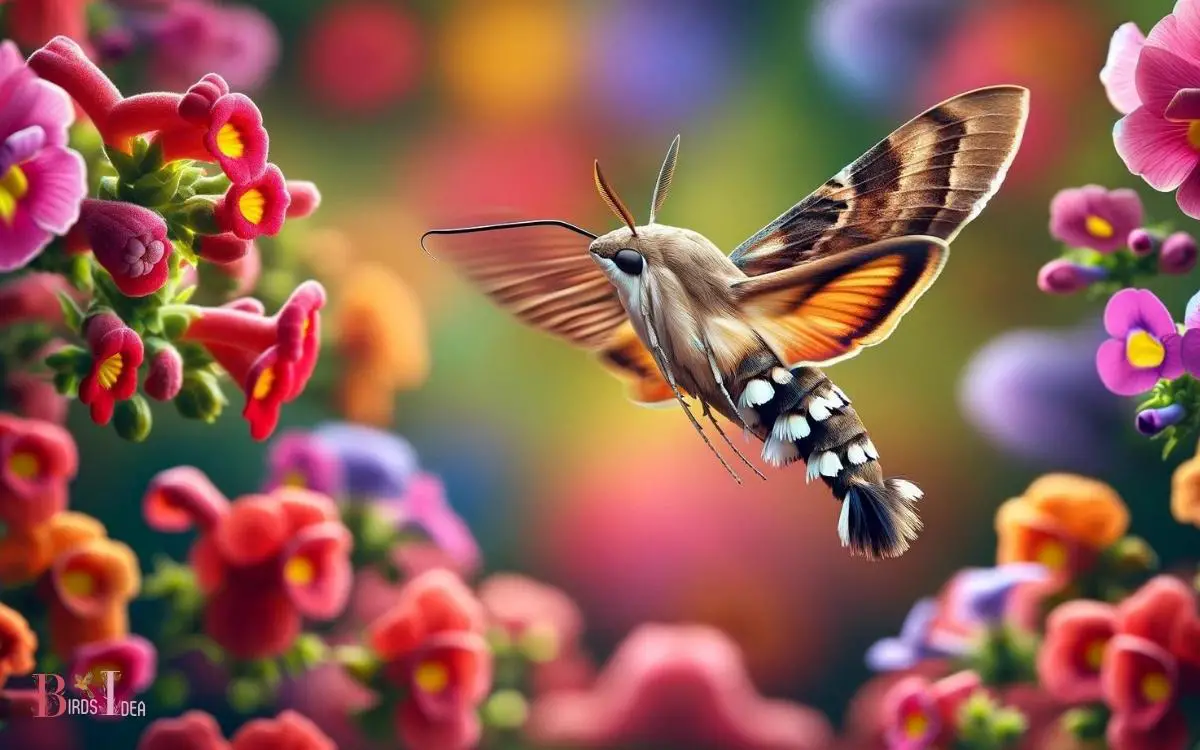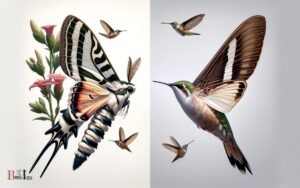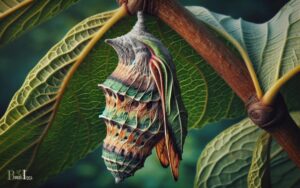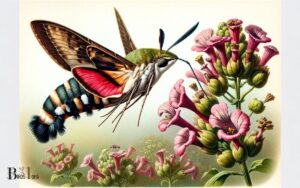Moth That Flies Like a Hummingbird: Hawk Moth!
The Hummingbird Moth, known for its resemblance to hummingbirds, is an insect that achieves a similar flight pattern through rapid wing movements. This moth, part of the Sphingidae family, is specifically referred to as the hawk moth.
Its capability to hover in mid-air and feed on nectar makes it a subject of fascination and study, revealing insights into its anatomy, habits, and role in ecosystems.
The Hummingbird Moth’s ability to fly like a hummingbird is due to several factors:
Discover the enchanting dance of the Hummingbird Moth, a master of aerial mimicry in the insect world.

Key Takeaway
Hummingbird Moth Characteristics and Flight Patterns
| Feature | Description |
|---|---|
| Scientific Name | Varies among species within the Sphingidae family |
| Common Name | Hummingbird Moth, Hawk Moth |
| Wingbeat Frequency | Similar to hummingbirds (up to 80 beats per second) |
| Proboscis Length | Long, enabling deep nectar extraction |
| Body Shape | Streamlined for agile flight |
| Wingspan | Varies, typically around 2 inches (5 cm) |
| Habitat | Widely distributed across the world, particularly in temperate and tropical regions |
| Role in Ecosystems | Pollinators, contributing to the reproduction of plants |
The Hummingbird Moth’s Remarkable Flight
It hovers with precision, darting from flower to flower in search of nectar. The hummingbird moth, also known as the hawk moth, exhibits a remarkable flight pattern that closely resembles that of a hummingbird.
With its rapid wingbeats and the ability to hover in mid-air, this moth defies the typical flight characteristics of its counterparts.
Its agile and acrobatic maneuvers allow it to access nectar from a variety of flowers, showcasing its remarkable flying capabilities.
This unique adaptation enables the moth to thrive in environments where nectar sources may be limited or difficult to access for other insects.
The hummingbird moth’s flight not only facilitates its own survival but also serves as a fascinating spectacle for observers in nature.
Physical Characteristics and Resemblance
The hummingbird moth exhibits physical characteristics and a flight pattern that closely resemble those of a hummingbird.
With its long, slender body, furry appearance, and rapid wing movement, the moth can easily be mistaken for its avian counterpart.
The wings of the hummingbird moth beat incredibly fast, often over 70 times per second, allowing it to hover in front of flowers while feeding, just like a hummingbird. Its coloration, including shades of green and brown, further adds to the striking resemblance.
The moth’s ability to fly backward and sideways, along with its agility and speed, further contribute to its hummingbird-like behavior.
These physical similarities and flight patterns have led to the hummingbird moth being a fascinating subject for researchers and nature enthusiasts alike.
Feeding Habits and Foraging Behavior
Exhibiting a voracious appetite for nectar, the hummingbird moth actively seeks out flowers to feed upon, displaying foraging behavior akin to its avian namesake.
This moth uses its long proboscis to reach deep into the flowers, extracting nectar while hovering in front of the blossoms, much like a hummingbird.
Its rapid wingbeats allow it to stay airborne while it feeds, further resembling the bird it emulates.
The hummingbird moth tends to prefer flowers with tubular shapes, which are well-suited to its feeding method.
This moth’s foraging behavior isn’t only efficient but also essential for its survival, as nectar serves as its primary source of energy.
By mimicking the feeding habits of hummingbirds, the hummingbird moth has adapted a successful strategy for obtaining the sustenance it requires.
Evolutionary Adaptations for Hovering
The moth’s ability to hover like a hummingbird is a result of its evolutionary adaptations. Its wing morphology allows for sustained hovering, similar to that of a hummingbird.
The similarities in feeding behavior further highlight the convergent evolutionary paths of these two distinct species.
Wing Morphology for Hovering
Researchers have discovered the moth’s wing morphology possesses evolutionary adaptations for hovering, enabling it to mimic the flight pattern of a hummingbird.
The following features contribute to the moth’s ability to hover like a hummingbird:
- Flexible wings that allow for intricate movements and rapid adjustments in flight.
- Wing shapes that create vortices, generating lift and providing stability during hovering.
- High wingbeat frequency, similar to that of a hummingbird, enabling sustained hovering.
- Fine-scale wing structures that minimize turbulence and enhance control during hovering.
- Specialized muscle and joint adaptations that support the rapid and precise wing movements required for hovering.
These evolutionary adaptations in wing morphology highlight the remarkable convergence between moths and hummingbirds, showcasing nature’s ingenuity in independently evolving similar flight capabilities.
Feeding Behavior Similarities
Evolutionary adaptations in the moth’s wing morphology also contribute to its feeding behavior, particularly in the context of hovering while seeking nectar.
The shape of the moth’s wings allows it to generate lift efficiently, enabling sustained hovering, similar to hummingbirds.
Additionally, the moth’s ability to rapidly beat its wings at a high frequency, combined with precise wing control, facilitates its ability to hover in front of flowers while feeding.
Moreover, like hummingbirds, the moth has developed a long proboscis to access nectar from deep within flowers, showcasing a remarkable convergence in feeding strategies between these seemingly disparate species.
These similarities in feeding behavior highlight the evolutionary pressures that have led to the development of analogous adaptations in both moths and hummingbirds for efficient hovering and nectar acquisition.
Geographic Distribution and Habitat
The moth that flies like a hummingbird has a diverse geographic distribution, with different species inhabiting a wide range of habitats.
Some species are found in tropical rainforests, while others prefer temperate woodlands or even urban areas.
Understanding their habitat preferences and geographic distribution patterns is crucial for conservation efforts and further research into their unique adaptations.
Habitat Preferences and Range
Although often associated with tropical regions, the moth that flies like a hummingbird can actually be found in a wide range of habitats across different geographic locations.
This remarkable moth can be found in:
- Tropical rainforests: These lush, dense forests provide abundant nectar sources and a warm climate, making them an ideal habitat for the moth.
- Temperate woodlands: Even in cooler climates, the moth can thrive in woodlands with diverse flowering plants.
- Coastal areas: The moth is often seen in coastal regions, where it can feed on the nectar of flowering plants along the shoreline.
- Suburban gardens: Surprisingly, these moths are adaptable and can be found in urban and suburban areas, particularly where there are flowering plants.
- Mountainous regions: Some species of these moths inhabit mountainous areas, where they’ve adapted to the unique flora and climate.
Geographic Distribution Patterns
Found in a variety of habitats across different geographic locations, the moth that flies like a hummingbird demonstrates remarkable adaptability to diverse environments.
This species can be found in regions ranging from North America to Central and South America.
The table below provides a summary of the geographic distribution and habitats where this unique moth can be found.
| Geographic Location | Habitat |
|---|---|
| North America | Forests, grasslands, gardens |
| Central America | Tropical rainforests, mountainous regions |
| South America | Coastal areas, deserts, savannas |
This widespread distribution showcases the moth’s ability to thrive in various ecosystems, from temperate forests to tropical rainforests and even arid deserts.
Such adaptability contributes to the species’ survival and ability to pollinate a wide range of flowering plants.
What makes the Hawk Moth fly like a hummingbird?
The Hawk Moth, also known as the hummingbird hawk moth, is able to fly like a hummingbird due to its unique physical characteristics. With its rapid wingbeats and ability to hover in mid-air, this moth closely resembles a hummingbird in its flight patterns. These hummingbird hawk moth facts showcase the incredible abilities of this fascinating creature.
The Impact of Human Activity
Human activity has significantly altered the natural habitats of various species of moths, affecting their behavior and survival.
The impact of human activity on moths includes:
- Habitat destruction: Deforestation and urbanization have led to the loss of moth habitats.
- Pollution: Chemical pollutants affect moths directly and degrade their food sources.
- Artificial lighting: Urban areas with bright lights disrupt moth navigation and mating behaviors.
- Climate change: Shifts in weather patterns and temperatures directly impact moth populations and their food sources.
- Pesticide use: Widespread use of pesticides harms moth populations and disrupts their role in ecosystems.
These factors combine to create significant challenges for moth populations, threatening their survival and disrupting the delicate balance of ecosystems.
Conclusion
The remarkable flight of the Hummingbird Moth is a sight to behold. With its physical characteristics and resemblance to a hummingbird, it’s no wonder it captivates onlookers.
Its evolutionary adaptations for hovering and unique feeding habits are truly a marvel of nature.
As human activity continues to impact its habitat, we must strive to protect and conserve this incredible creature, ensuring that future generations can also witness this ‘diamond in the rough.’






